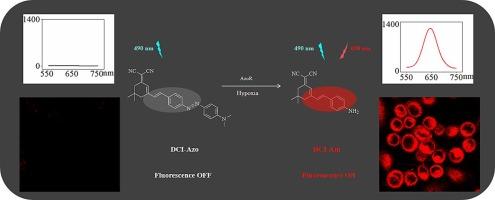基于二氰异佛尔酮的缺氧近红外荧光探针及其在 Hela 细胞成像中的应用。
IF 4.3
2区 化学
Q1 SPECTROSCOPY
Spectrochimica Acta Part A: Molecular and Biomolecular Spectroscopy
Pub Date : 2024-11-04
DOI:10.1016/j.saa.2024.125383
引用次数: 0
摘要
缺氧会加速肿瘤的转移和恶化,从而限制化疗或放疗的效果。因此,开发高效的肿瘤细胞缺氧检测技术对癌症诊断和治疗极为重要。在这项工作中,我们报道了一种基于二氰异佛酮的探针(DCI-Azo),它能通过缺氧上调偶氮还原酶(AzoR)特异性地开启其近红外发射。为了降低合成难度和简化后处理过程,我们采用一锅合成法合成了近红外荧光团(DCI-Am),收率达 97%。在该荧光团的基础上,设计并合成了 DCI-偶氮。用 Na2S2O4 和大鼠肝脏微粒体评估了 DCI-Azo 对体外缺氧的敏感性。它具有近红外发射(λem = 650 nm)、大斯托克斯位移(>160 nm)、高灵敏度(LOD 0.53 μg mL-1 大鼠肝脏微粒体)、高选择性和低细胞毒性(培养 24 小时后细胞存活率> 80%)。此外,该探针还成功用于检测 Hela 细胞和小鼠模型肿瘤组织中的缺氧(1% O2)。当氧气水平从 21%O2 降至 1% 时,Hela 细胞的荧光强度增加了 26 倍。与附近的正常区域相比,肿瘤区域的荧光强度增强了 5 倍。所有这些特征都表明,探针 DCI-Azo 是一种用于体内检测和成像的多功能工具,可用于癌症诊断研究。本文章由计算机程序翻译,如有差异,请以英文原文为准。

A near infrared fluorescent probe for hypoxia based on dicyanoisophorone and its application in Hela cells imaging
Hypoxia will accelerate tumors metastasis and deterioration, thereby limiting the effects of chemotherapy or radiotherapy. Thus, developing efficient techniques for detecting hypoxia in tumor cells is extremely important for cancer diagnosis and therapy. In this work, we reported a dicyanoisophorone-based probe (DCI-Azo) that specifically switched on its near infrared emission with hypoxia up-regulated azo-reductase (AzoR). In order to reduce the difficulty of synthesis and simplify the post-processing process, we adopted a one-pot-synthesis method to synthesized NIR fluorophore (DCI-Am) with yield 97 %. Based on the fluorophore, DCI-Azo was designed and synthesized. The sensitivity of DCI-Azo for hypoxia in vitro was evaluated with Na2S2O4 and rat liver microsomes. It exhibited near-infrared emission (λem = 650 nm), large Stokes Shift (>160 nm), high sensitivity (LOD 0.53 μg mL−1 rat liver microsomes), high selectivity, and low cytotoxicity (cell viability > 80 % after incubation for 24 h). Moreover, the probe was successfully used for detecting hypoxia (1% O2) in Hela cells and tumor tissue in mouse model. The fluorescence intensity in Hela cells has increased ∼ 26-fold when the oxygen level is reduced to 1 % from 21 % O2. The fluorescence intensity of the tumor area enhanced ∼ 5 folds compared to the normal area nearby. All these features demonstrated that the probe DCI-Azo was a versatile tool for in vivo assay and imaging for cancer diagnosis studies.
求助全文
通过发布文献求助,成功后即可免费获取论文全文。
去求助
来源期刊
CiteScore
8.40
自引率
11.40%
发文量
1364
审稿时长
40 days
期刊介绍:
Spectrochimica Acta, Part A: Molecular and Biomolecular Spectroscopy (SAA) is an interdisciplinary journal which spans from basic to applied aspects of optical spectroscopy in chemistry, medicine, biology, and materials science.
The journal publishes original scientific papers that feature high-quality spectroscopic data and analysis. From the broad range of optical spectroscopies, the emphasis is on electronic, vibrational or rotational spectra of molecules, rather than on spectroscopy based on magnetic moments.
Criteria for publication in SAA are novelty, uniqueness, and outstanding quality. Routine applications of spectroscopic techniques and computational methods are not appropriate.
Topics of particular interest of Spectrochimica Acta Part A include, but are not limited to:
Spectroscopy and dynamics of bioanalytical, biomedical, environmental, and atmospheric sciences,
Novel experimental techniques or instrumentation for molecular spectroscopy,
Novel theoretical and computational methods,
Novel applications in photochemistry and photobiology,
Novel interpretational approaches as well as advances in data analysis based on electronic or vibrational spectroscopy.

 求助内容:
求助内容: 应助结果提醒方式:
应助结果提醒方式:


